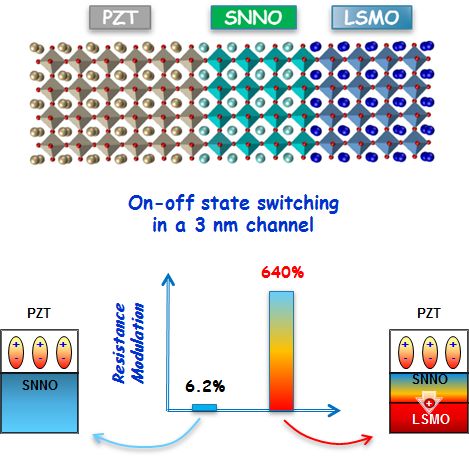 Complex oxide materials possess a plethora of technology-critical functionalities that span the entire electronic and magnetic spectra. The structural similarity among them makes it possible to achieve functional design of oxide heterostructures, which can be used as the building blocks for energy efficient nanoelectronics with performance transcending the existing semiconducting technology. Nebraska MRSEC researchers have fabricated such complex oxide heterostructures with atomic precision, exploiting them to build a prototype nonvolatile Mott transistor. Working with a ferroelectric Pb(Zr,Ti)O3 (PZT) gate, they have achieved room temperature on-off switching in a couple of nanometer-thick Mott channel Sm0.5Nd0.5NiO3 (SNNO). Significant enhancement in the channel resistance switching has been achieved by interfacing SNNO with an ultrathin La0.67Sr0.33MnO3 (LSMO) layer, leveraging the interfacial charge transfer effect between SNNO and LSMO. This study points to a new material strategy to achieve bulk-inaccessible functionalities via atomistic design of complex oxide hetero-interfaces, bridging its gap with practical applications. Chen et al., Adv. Mater. 29, 1701385 (2017)
Complex oxide materials possess a plethora of technology-critical functionalities that span the entire electronic and magnetic spectra. The structural similarity among them makes it possible to achieve functional design of oxide heterostructures, which can be used as the building blocks for energy efficient nanoelectronics with performance transcending the existing semiconducting technology. Nebraska MRSEC researchers have fabricated such complex oxide heterostructures with atomic precision, exploiting them to build a prototype nonvolatile Mott transistor. Working with a ferroelectric Pb(Zr,Ti)O3 (PZT) gate, they have achieved room temperature on-off switching in a couple of nanometer-thick Mott channel Sm0.5Nd0.5NiO3 (SNNO). Significant enhancement in the channel resistance switching has been achieved by interfacing SNNO with an ultrathin La0.67Sr0.33MnO3 (LSMO) layer, leveraging the interfacial charge transfer effect between SNNO and LSMO. This study points to a new material strategy to achieve bulk-inaccessible functionalities via atomistic design of complex oxide hetero-interfaces, bridging its gap with practical applications. Chen et al., Adv. Mater. 29, 1701385 (2017)
picture right: PZT-gated SNNO/LSMO composite channels exhibit significantly enhanced field effect switching due to interfacial charge transfer between SNNO and LSMO.